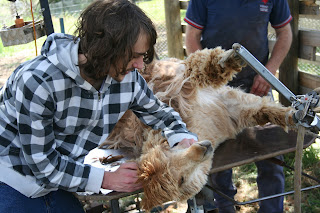Small Farming: Alpaca Yards
It is a little known fact that alpacas can fly short distances when being gathered together for shearing. I have had reason to reflect on this, as a tree fall recently wiped out my old yards. Which was a good thing, because i really didnt have the first idea about building yards for alpacas when i started. So, I am able to start from first principles.
First of all, alpacas grow wool.
Once a year they (and any human helpers nearby) should be shorn. They hate being shorn, and will fly, if the opportunity presents itself. (Alpacas are fully restrained during the actual shearing to prevent the necks being broken or movement that might result in the shears cutting the abdomen.)
They hate being shorn for reputational reasons. Shorn alpacas look a bit like oversized rats, and they know it.
The purpose of yards is to be able to gather and sequentially deal with alpacas without them killing you, or hurting them. Both can happen. Alpacas have a deadly kick. Pregnant alpacas are particularly vulnerable when placed in stress - an attempt to fly over poorly built fences can end in disaster.
Shearing and general management yards must be able to be managed by a single person. Dogs don't work around alpacas. Alpacas stomp dogs (and cats). Yards must have the following features:
- a holding area (with high secure fences)
- a 'press area' (where the human can safely push the alpacas into a tight group)
- a 'race' (where individual alpacas can be singled out and treated or brought out for shearing).
Central to the yards is the 'press gate' - a gate inside the holding yard that swings and pushes the alpacas into a group in front of the race. All the other elements must work around the 'press gate' - it can't simply be an afterthought.

















Comments